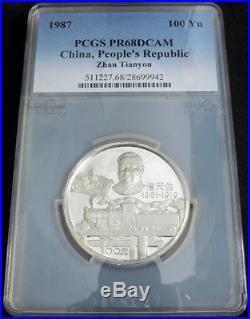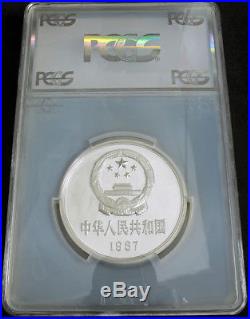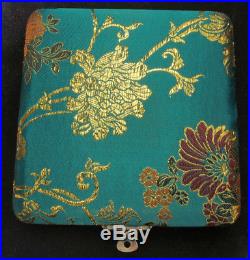



Proof Silver 100 Yuan (12 Oz) Coin. + BOX & COA. Mint Year: 1987 Mintage: 2,911 pcs. Certified and graded by PCGS as PR-68 DCAM + Original Box of Issue + COA! Denomination: 100 Yuan (12 Oz) – 125th Anniversary – Birth of Zhan Tianyou Material: Silver. 900 – 11.987 oz. ASW Weight: 373.23gm Diameter: 80mm. Jeme Tien Yow (26 April 1861 – 24 April 1919) was a distinguished Chinese railroad engineer. Educated in the United States of America, he was the chief engineer responsible for construction of the Imperial Peking-Kalgan Railway (Beijing to Zhangjiakou), the first railway constructed in China without foreign assistance. Jeme Tien-yow was born in Nam-hoi prefecture (now Liwan District, Guangzhou) in Guangdong of China. His family came from Wuyuan County in Hui Prefecture (which was then located in Anhui Province but is now in Jiangxi Province). In 1872, as a twelve-years-old, he was chosen by Qing imperial officials to be sent to the United States as part of the Chinese Educational Mission. Together with thirty children of similar age, he arrived in Connecticut. After studying at a primary school in New Haven, he then entered a secondary school there, and in 1878, was admitted to Yale University. His major was Civil Engineering, with an emphasis in railroad construction, and received his bachelor’s degree in 1881. He was considered lucky, because only a few months after his graduation, the Qing government decided to recall all students studying in the United States. Of those who were sent abroad, only he and another student were able to obtain their college degrees. Life was not good for the students recalled to China. The Qing government officials found the behavior of these foreign-educated students to be un-Chinese. They enjoyed playing baseball and had their queues cut off. The government did not put to good use the knowledge acquired in the USA. Most of the recalled students, including Jeme, were simply sent to work in commerce as translators or as officers in the newly-formed Imperial Navy. Jeme was sent to the Fujian Arsenal at Fuchow. A few years later, in 1884, the Imperial Navy at Fuchow was destroyed during the Sino-France War. In 1888, Jeme finally found his way to become a railroad engineer. Viceroy Li Hongzhang in Peking was constructing a railroad that would link Tientsin to the coal mines in Tangshan. A British engineer, Claude W. Kinder, was hired as the chief engineer of the railroad. Through connections with his old schoolmates working in Peking, Jeme joined Kinder as an intern engineer. He was soon promoted to engineer, and later the district engineer. The railway that he worked on was later extended to become the Peking Mukden Line. He spent 12 years on various sections of this line before his next major assignment. In 1902, Yuan Shikai decided to build a special line for Empress Dowager Cixi so she could visit the tombs of her royal ancestors. Kinder was the original candidate for chief engineer, however the French were unhappy that an Englishman was assigned to the position. Eventually, Jeme got the assignment as the chief engineer of the 37 kilometres (23 mi) stub line. He managed to construct the railroad within budget and to a very tight schedule. The Empress was pleased and permission was given to construct more railroads in China. In 1905, the Imperial Qing government decided to build a railroad that would link the capital of Peking to the important trade city of Kalgan to the north. This railway would be of strategic importance to the government. The decision was therefore made that the railway would be built without foreign assistance. Capital would come from the government, and no foreign engineers were to be hired. Jeme was once again appointed as chief engineer of the railway. In the beginning, some people were skeptical that the government would be able to construct the railroad all by itself in the rugged mountains north of Peking. However Jeme showed he was an able engineer and completed the work two years ahead of schedule and under budget. He included a zig zag section near the Qinglongqiao (Ching-lung-chiao) railway station to overcome the steep gradient. When excavating the Badaling railway tunnel, he accelerated construction by drilling a vertical shaft into the path of the tunnel. This doubled the number of digging teams that could be employed. He was also said to be a technical advisor for the construction of the Lo Wu Bridge built in 1906 as part of the Kowloon-Canton Railway. For his contributions to railroad engineering in China, Jeme was often called the “Father of China’s Railroad”. Jeme was subsequently elected a member of the North British Academy of Arts in 1909. He was a founding member of the China Institute of Engineers, and was awarded an honorary doctorate by the University of Hong Kong in 1916. Jeme died in Hankou in 1919 at the age of 58, and was buried at the Qinglongqiao railway station, where the Peking-Kalgan (Beijing-Zhangjiakou) railway crossed the Great Wall and the rugged mountains north of Beijing. A museum was also established nearby to commemorate his achievements. The item “1987, China. Proof Silver 100 Yuan (12 Oz) Coin. + BOX & COA. PCGS PR-68 DCAM” is in sale since Thursday, May 21, 2015. This item is in the category “Coins & Paper Money\Coins\ World\Asia\China\PRC (1949-Now)”. The seller is “coinworldtv” and is located in Europe. This item can be shipped worldwide.
- Circulated/Uncirculated: Uncirculated
- Certification: PCGS
- Grade: PR 68
- Certification Number: 28699942
